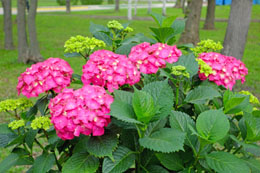From florist to climbing to peegee, hydrangeas come in a variety of types. When should they be pruned is decided based on the type of hydrangea. This article briefly explains a few different kinds of hydrangeas and when exactly should they be pruned and trimmed.

The pruning time and method of shearing the branches/leaves varies for each kind of hydrangeas. However, one thing that's common to all types is the removal of spent blooms and dead stems. For appropriate pruning, it is necessary to be able to identify and differentiate between the different types correctly. Pruning is an important part of hydrangea care and should not be overlooked.
Florist Hydrangea: Its botanical name is
Hydrangea macrophylla. It is also referred to as Mophead and Bigleaf. Colors of the blooms of these hydrangeas change with pH of soil. Acidic soils would yield flowers that are blue in color, while alkaline soils would yield pink blooms. Some florist hydrangeas might also grow white-colored flowers. Its dark green and glossy leaves make the identification process a bit easier, too. Another sign for identifying the leaves is their serrated border/margin.
These hydrangeas should essentially be pruned after the flowers fade away. The older and dead branches need to be pruned in a timely manner. However, pruning out all the old branches is not advisable since, they provide support for new growth. Make sure you don't prune the trees during spring and later fall. If done so, the buds and thereby, blooms are lost.
Climbing Hydrangea: Unlike other hydrangeas, that are basically shrubs, the climbing hydrangea is actually a vine (climber plant). Minimal pruning during the summer season serves the purpose in this case. Initiate pruning only when the plant is properly established in a given area and attains vigorous growth.
Peegee Hydrangea: The flowers of this plant grow in big, snowball-shaped clusters. The plant blooms from mid to late summer. Flowers are initially white in color and turn pink as they begin to mature. Pruning is mainly carried out to stop its excess growth. The best season for pruning Peegee hydrangeas is between late winter and the beginning of spring, since it promotes the growth of flower buds. To keep the plant in shape, dead flowers should be cleared off.
Oakleaf Hydrangea: Its botanical name is
Hydrangea quercifolia. It can be identified from its oakleaf-shaped leaves. Pruning time for this hydrangea extends from late winter to early spring. During this period, the dead wood must be removed.
Remember, pruning is necessary for the healthy growth and survival of hydrangeas and it should be carried out regularly. Keep the above mentioned details in mind when you prune the hydrangeas in your backyard the next time.






 The pruning time and method of shearing the branches/leaves varies for each kind of hydrangeas. However, one thing that's common to all types is the removal of spent blooms and dead stems. For appropriate pruning, it is necessary to be able to identify and differentiate between the different types correctly. Pruning is an important part of hydrangea care and should not be overlooked.
The pruning time and method of shearing the branches/leaves varies for each kind of hydrangeas. However, one thing that's common to all types is the removal of spent blooms and dead stems. For appropriate pruning, it is necessary to be able to identify and differentiate between the different types correctly. Pruning is an important part of hydrangea care and should not be overlooked.